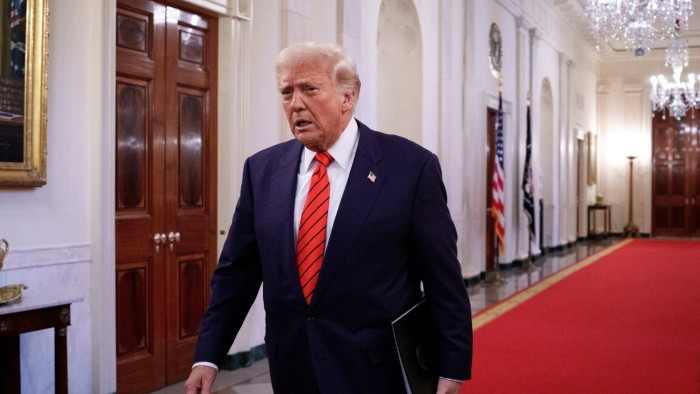Good morning and welcome back to Energy Source, coming to you from New York.
European energy groups are pumping the brakes on their green commitments. Yesterday, the world’s largest wind developer Ørsted cut planned investment to 2030 by 25 per cent and scrapped its renewables target. The move came hours after its major shareholder Equinor said it would increase fossil fuel production and halve spending on renewables.
Equinor’s pivot is the latest in the trend of oil and gas producers diluting plans to diversify away from fossil fuels as shareholders demand oil-and-gas level returns.
In today’s Energy Source, we try to make sense of Trump’s tariff chaos and its implications for the US energy sector.
Thanks for reading,
Amanda
Trump’s trade wars threaten plans for energy dominance
It’s only Thursday, but this week has felt like a year with US President Donald Trump’s escalating threats to disrupt global energy markets and the economy along with them.
We started the week with threats of 25 per cent tariffs on two of the largest US trade partners, Canada and Mexico, which were delayed. But 10 per cent levies on China went in effect on Tuesday, followed by Beijing’s retaliation. Then, Trump called for a return to “maximum pressure” on Tehran, ordering the Treasury and other agencies to “drive Iran’s export of oil to zero”.
Trump’s opening salvos appear more bark than bite when it comes to energy. Despite sanctions, Iran’s exports of crude grew under Joe Biden’s administration, surpassing 1.6mn b/d of crude in 2024, with the vast majority headed to China and south-east Asia, according to S&P Global Commodity Insights.
While stricter sanctions enforcement could drive Iran’s exports down, they probably won’t fall to zero, say analysts. And with the global oil market in oversupply, sanctions are unlikely to trigger a price rally, which Trump does not want anyway.
“The fact is that higher oil prices equal higher gas prices and are . . . a political hot potato back at home,” said Sipan Habib, a derivatives trader at Novion, a brokerage firm.
Trump’s tariffs on China, and Beijing’s response, have only modest impacts for energy. While the US relies heavily on the Asian country for cleantech components and raw materials, these imports are already subject to steep tariffs.
Beijing’s new levies target shipments of US crude, liquefied natural gas and coal, which account for only a small fraction of flows between the two countries.
Matt Smith, lead oil analyst at Kpler, said: “Doing retaliatory tariffs makes China look as if it is standing up to the US, but in the grand scheme of things, when you look at the flows involved, they are very small pieces of the pie.”
The most devastating elements of Trump’s trade plans have been averted. Tariffs on Canada and Mexico would have raised prices in the US for petrol and diesel, pushed up costs for electricity and hurt domestic manufacturers.
While the US is the largest producer of oil and gas, many of its refineries depend solely on crude imports from Canada and Mexico — which are heavier and lower quality — to produce petrol and diesel, the latter being a key driver of inflation.
The US also relies heavily on the two countries for grid equipment such as transformers, which are essential to deliver the insatiable amounts of electricity needed to power artificial intelligence data centres. States in the north-east, where land is scarce, import large amounts of hydroelectric power and pipeline gas from Canada.

Jeffrey Clark, chief executive of the Advanced Power Alliance, an industry group, warned the risk of higher energy costs from tariffs threatened the president’s ambitions to bolster domestic manufacturing.
“One of the things that the United States has done well with the rise of renewable energy and bringing cheaper, lower carbon forms of energy into the market is we’ve been able to bring manufacturing back to the United States,” Clark said. “It would be a self-inflicted wound . . . if we were to raise our own energy prices in an effort to try to put pressure on other countries.”
Tariffs also threaten project commitments by raising input costs for domestic manufacturers. A car built in North America, for example, crosses the US-Mexico border several times before it’s finished, with petrol-guzzling cars more vulnerable than electric ones, which have fewer parts.
“We cannot be isolationist yet,” said Erik Underwood, chief executive of Basis Climate, a company that facilitates the tax credit transactions that have helped fuel a boom in US cleantech manufacturing investments. “This is still a very globalised world where you have extremely international supply chains.”

Where Trump inflicted pain this week and where he eventually pulled back underscore his conflicting priorities on energy and trade. While the president wants to carry a big stick with sweeping tariffs, the very act threatens his plans to bolster the country’s oil and gas sector, lower prices, and strengthen domestic manufacturing.
Antoine Vagneur-Jones, head of trade and supply chains at BloombergNEF, told Energy Source: “Things that the Trump administration wants to do like onshore manufacturing, like build out data centres, even putting an emphasis on [internal combustion engine] vehicles over electric vehicles . . . these tariffs, in some cases, run contrary to some of those objectives.” (Amanda Chu)
Behind the Money podcast
On day one of his presidency, Trump signed multiple executive orders to bolster the US’s oil and gas production, lower energy prices and tackle inflation. But producers are unlikely to follow the president’s marching orders to “drill, baby, drill”.
The FT’s US energy team has a new podcast out this week on why the economics of oil and gas production are colliding with Trump’s energy vision. Give it a listen here.
Job moves
-
Sila, a battery materials start-up, appointed Lindsay Caldwell, as vice-president of people. She joins from Metagenomi.
-
US oilfield services company Liberty Energy named Ron Gusek as its new chief executive, after its former chief Chris Wright was confirmed as US secretary of energy.
-
Kazi Hasan joins Opal Fuels as chief financial officer, replacing interim CFO Scott Contino. Hasan previously served as a senior adviser at Fluence Energy and CFO at Puget Sound Energy.
-
Ørsted has replaced chief executive Mads Nipper with deputy chief executive and chief commercial officer Rasmus Errboe.
-
Jeff Lyash is retiring from Tennessee Valley Authority, where he served as chief executive.
-
Lilly Yejin Lee is leaving Columbia University’s Center on Global Energy Policy, where she assisted founding director Jason Bordoff. She is joining TotalEnergies as a senior market analyst.
Power Points
Energy Source is written and edited by Jamie Smyth, Myles McCormick, Amanda Chu, Tom Wilson and Malcolm Moore, with support from the FT’s global team of reporters. Reach us at energy.source@ft.com and follow us on X at @FTEnergy. Catch up on past editions of the newsletter here.
Recommended newsletters for you
Moral Money — Our unmissable newsletter on socially responsible business, sustainable finance and more. Sign up here
The Climate Graphic: Explained — Understanding the most important climate data of the week. Sign up here


